Jazz and Faust Preview
Will this game revive the slumping adventure genre? Read on to find out.
PC gaming has always lent itself best to certain genres. The shelves of your local software store are at this very moment lined with untold copies of the latest first-person shooters, simulations, and real-time strategy games. Those of us who have been playing PC games since the good old days remember another genre that once dominated shelf space: the hallowed point-and-click adventure game. In the halcyon adventuring days of the late '80s and early '90s, good adventure games were a dime a dozen. Even now, the mention of favorites like King's Quest, Maniac Mansion, and Loom can still warm an old adventurer's heart. In recent years, however, the flow of adventure games has slowed to a mere trickle. What's an old adventure-game fan to do?

Enter Russian software maker 1C Company. Previously unheard of in the Western Hemisphere, 1C will change that soon with the release of developer Saturn+'s Jazz and Faust, a game that returns to and upholds the tenets of the old-style adventure genre. Is Jazz and Faust the unlikely savior of adventure gaming? It may or may not rejuvenate the PC audience's lost demand for adventure games, but at the very least, Jazz and Faust will serve as another refreshment for the thirsty adventurer.
Jazz and Faust casts you as either of the two title characters--you're allowed to choose which one on starting a new game. Your choice of character determines more than just the player model you'll be pushing around the screen, however. Each of the game's main characters takes part in the same overall story arc, but their two adventures are mostly divergent. When you play as one character, you'll meet up with the other at various points throughout the story, and thus when you play as the second character, you'll witness the same events taking place from a different perspective. Despite the amount of time the two main characters will spend together, both Jazz and Faust have entirely unique paths to follow and puzzles to solve, so playing through with both characters will be a must if you want to see everything the game has to offer.
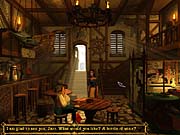
Jazz and Faust opens for both characters in the same place, the city of Er-Elp, and at about the same time, but each one finds himself in a unique predicament. Jazz, the profit-minded smuggler, has landed himself in jail, and he is granted a three-day reprieve during which he must collect enough money to pay off the court and win his freedom. Faust, the noble seafaring captain of the ship Invisible, is waiting for a strange and nameless passenger who needs quick transport away from Er-Elp. The man never returns from his brief errand, though, and both Jazz and Faust soon find out about the grisly murder of two foreigners that has occurred during the night. The police close the city's port while an investigation takes place, and Jazz and Faust both set out, independent of each other, to uncover more information about the bizarre goings-on. Of course, they soon become embroiled in a larger and more elaborate plot that will take them to a variety of exotic locales.
The Rigors of Adventure
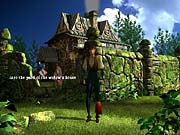
The adventure-game interface used to be a topic of fierce debate among connoisseurs of the genre. Old stalwarts argued that the text parser allowed full freedom of interaction with the environment; if you could type it, you could conceivably do it. Later games featured the "innovation" of tools like the icon bar, which gave you the most-used abilities, such as walk, look, talk, and operate, at the touch of a mouse button. Like most recent adventure games, Jazz and Faust uses the more simplified version of this system, which comes in the form of a single, all-purpose mouse cursor. Though it seems that this gradual reduction of the adventure game interface constricts your chances to interact with the environment, the increased scope of games like Jazz and Faust makes this change understandable.
Directing Jazz or Faust around the game's various environments is a straightforward process. Each background contains a number of hot spots that can be acted upon in some manner, and the mouse cursor will change to an icon denoting the appropriate action whenever it passes over one of these spots. A spyglass icon means you can examine the area you're clicking on, eliciting a comment from your character; the hand indicates an item that can be picked up or used in some way; and the dragon icon appears for other characters and is generally used for speaking. A standard adventure-game inventory rounds out the interface, and of course you can attempt to use objects you've picked up on the people and areas you encounter.
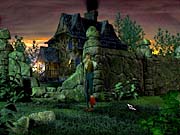
As in any good adventure game, creative use of inventory items is one essential part of solving problems in Jazz and Faust. The game's puzzles are pretty standard adventure fare, for the most part. Like in other games of this type, you'll do a lot of trading inventory items back and forth for information or new items. For instance, in one scene Jazz asks an old widow for news of the recent murders, but she refuses to respond, saying she's waiting for the cloth seller. It just so happens, of course, that Jazz has a piece of imported cloth he bought from the salesman in the square with part of the money he gained through selling his ship...Obtaining new items and opening up new areas to explore generally depends on this "trade item A for item B and take it to person C" sort of model, which should sit well with seasoned adventure-game players, since it's been in use since the genre was in its early stages.
Jazz and Faust plays like a classic adventure game, and it should last as long as one too. The game contains more than 80 background scenes, and your tasks will have you revisiting these scenes multiple times over the course of the game. Those who find themselves disappointed by short adventure games shouldn't have to worry about finishing Jazz and Faust too quickly, and the fact that each character has an entirely different quest should add even more replay value to the game.
From Green Fields to Dank Dungeons
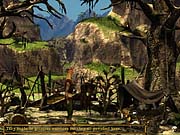
Jazz and Faust uses standard adventure-game elements of presentation, such as real-time 3D characters on prerendered bitmap backgrounds. These backdrops are of special note--they depict a surprisingly diverse array of culturally influenced lands and architecture. From the medieval European styling of Er-Elp to a Middle Eastern marketplace, there's a lot of scenery to appreciate. The game also takes you to graveyards, deserts, dungeons, and a variety of other staple adventure-game locations. Some of the game's scenes can also be visited during the day and at night, which gives Jazz and Faust a greater sense of progressing time.
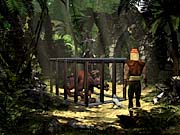
These backgrounds are interesting to look at, but since they're prerendered, they don't exhibit the liveliness that many real-time games do. Jazz and Faust does have a few graphical niceties to enliven the otherwise static surroundings, though, like flames and a nice character shadow effect. The character modeling ranges from decent to merely passable, but then again, some of the best adventure games have mediocre graphics, so hard-core genre fans should have no problems here.
In fact, Jazz and Faust's somewhat average graphics are offset by the game's astonishingly low system requirements. According to the publisher, it will currently run on a mere Pentium 233 with 32MB of RAM, and only a 1MB video card with no 3D functions is required. In this age of ever-inflating memory requirements and video cards that cost more than the latest game console, it's refreshing to see a developer creating games that will run on yesterday's hardware. Jazz and Faust's light requirements may help it find an audience among adventure-game fans who haven't bothered to upgrade their rigs to play flashier genres.
The current build of Jazz and Faust seems to be shaping up pretty well, despite a few minor issues. The game's translation to English at this stage of development is a little uneven, but we're told it will get the full benefit of an American localization before it's released in the States. The game also features full voice acting, but so far all the spoken dialogue is in Russian. Again, though, the American release of the game will feature full English voice acting. Finally, despite the low system requirements, the game's frame rate tends to drop when there are a lot of real-time characters on the screen at once. Hopefully, though, this can be chalked up to a lack of code optimizations and will be improved for the final release.
Jazz and Faust is already looking polished in its current state, and the few problems that remain will be ironed out before its release in the United States in the second quarter of this year. The game will mark 1C Company's first publishing venture in America, with more games to follow. Adventure-game aficionados will certainly want to keep their eyes peeled for Jazz and Faust--at the rate that classic-style adventures are released on the PC these days, we can't afford to let even one slip by. Watch GameSpot in the coming months for more information about the American release of Jazz and Faust.
Got a news tip or want to contact us directly? Email news@gamespot.com
Join the conversation